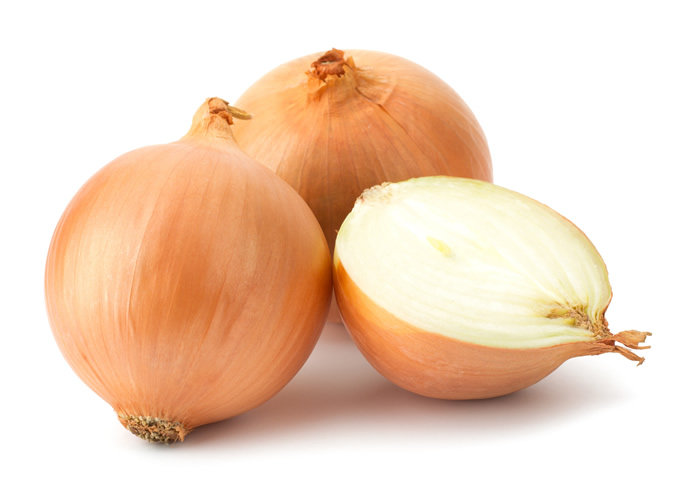
Onion
Usually, an onion weighs 100 grams on average. Depending on the variety, its weight varies, also its shape, well round, elongated or a little flattened and its color, yellow, red or white: a real string of colors and aspects! Main ingredient or flavor enhancer, onion is ubiquitous in our kitchens, always at hand.With a low caloric intake, the nutritional qualities of this vegetable are recognized. Rich in vitamins, minerals, trace elements and fiber, it is a source of well-being and balance. Raw, it exudes a powerful aroma and strong flavors that bake softens. Onion is available throughout the year.
Varieties
Yellow, red or white, there are many varieties of onions. However the real difference is between the early onions, harvested before maturity, and the dry onions (also called “on guard”). From the subtle safflower to the full-bodied yellow onion, there’s something for everyone!
First picture

1. Pearl onions come in many colors and varieties; great for boiling and pickling.
2. Bianco di maggio are Italian heirloom cipolline with white, sweet flesh.
3. More demure than European varieties, Thai shallots are great for spice pastes.
4. Spicy yellow storage onions, or common onions, are workhorses of the kitchen.
5. Italy’s famed, zesty Tropea lunga turn fragrant and luscious when grilled.
6. Grill or pickle tender, fresh torpedo onions, which have a concentrated sweetness.
7. Teardrop-shaped owas are slightly spicy and excellent for sauce bases.
8. Baby red Creole onions are so named because of their surprising spice.
9. Mayan sweets are fresh, juicy mild onions available in the States in fall and winter.
Second picture

10. Texas sweets are descendants of Bermuda onions, brought here in 1898.
11. Cipolline onions are flat Italian varieties that turn buttery when roasted.
12. The super-sweet candy hybrid is the ideal dried onion for caramelizing.
13. Large Red Bull onions keep longer than most dry onions and have a muted spice.
14. Inca sweet is a mellow variety from Peru sold fresh in the States during the winter.
15. French gray shallots are coveted by chefs for their creamy texture and refined flavor. Use them in vinaigrette.
16. Insanely sweet Walla Wallas are available in the summer from Washington State; you can eat them like apples.
Third picture

17. The sweet Siskiyou onion is harvested in the Pacific Northwest, sold fresh in summer, and is best raw.
18. Small, spicy turbo onions are a new storage variety with great heat.
19. Stuttgarters are classic dried yellow cooking onions often grown as pearls.
20. Late-season copras are surprisingly juicy and large for storage onions.
21. Heirloom red Wethersfields were grown by Thomas Jefferson, who loved their sweetness.
22. White granex is a cousin of Vidalia, a popular sweet onion from the South.
23. Since the 1880s, Australian browns have been prized for their pungent flesh, which is flavorful cooked.
24. Red baron is a smallish, popular red storage onion with pronounced sharpness.
Forth picture

25. Maui onions grow on the dormant Haleakala volcano; they’re ideal raw.
26. Red zeppelin are intensely oniony for reds; a popular hybrid for storage.
27. Red burgermeisters were bred to be sandwich onions. Sweet, with great crunch.
28. Often harvested young, Paris silver-skins are white, crisp, mild, and great for pickling.
29. French shallots have more spice and heat than Asian varieties. Excellent for sauces.
30. Crystal white wax is a mild, common pearl that retains its shape when cooked.
31. Jet set is a spicy small yellow onion that arrives early in the season.
32. Flat of Italy are heirloom Italian cipolline, ideal for roasting agrodolce, in a sweet-sour glaze.
33. Giant red hamburger is an aptly named variety that’s sweet and juicy and big as a bun.
Dried onions
Covered with a thin envelope called “the tunic”, the dried onions are eaten ripe when the foliage has faded, and the bulb has grown well in the ground. Sweet or full-bodied, subtle or rustic, their many varieties have multiple flavors, but differ in their color!
Buying tips
Here are some tips to choose from:
Firstly, the dry onion should be firm, with its shiny skin layers and no stains. Secondly, the bulb should be well dry.
Thirdly, choose the spring onion with a firm and shiny bulb, green stems, vigorous and crunchy.
Certainly, open your eyes wide: midges wandering on the tunic are also signs of putrefaction. Small sprouts begin to break? Go your way.
Finally, choose the onion according to the use that you wish to make: bulbs very plump to be stuffed, bells in a topping of roasted meat or poultry, red onions and new onions rather for raw preparations, etc.

Storage tips
Most importantly is that early onion can be stored in the crisper drawer of the refrigerator for up to a week in a clean damp cloth or airtight container.
Also, onion should be kept in a dry place, protected from light (otherwise it will germinate). In these conditions, it will keep its taste and nutritional qualities for a month or two.
Cooking tips
Above all, the onion is not demanding regarding cooking: pan-fried, fried, confit, oven-proof, frying pan and even pressure cooker! The onion is also delicious raw, although some varieties lend themselves more than others. For example, treat yourself to a rustic snack and simply enjoy it with a slice of bread, a piece of cheese and a good glass of wine, like the Greek herdsmen of antiquity.
Also, they are suitable for almost all types of cooking: with the pressure cooker in a pan or wok, with a grill oven! Have you tried the “onions rings”? They are easy to prepare! Cut the onions into thick bracelets and marinate in vinegar for about 12 hours. Sponge them and then pass them successively in the beaten egg and a breadcrumb. Let sit and fry these “rings” Serve them with a sauce well raised, guacamole type.
